-
Posts
659 -
Joined
Content Type
Profiles
Forums
Gallery
Events
Posts posted by David Lester
-
-
The discussion of the best glue for ratlines in another thread has me thinking about my seizings. The consensus seems to be that anything other than CA glue is the way to go, but for some reason I cannot seem to get anything other than CA to actually secure my seizings. I've tried PVA, watered down PVA, podge, shellac and varnish. In every case, the seizing will always fail. After I've let the glue dry, I snip the ends of the seizing line and everything will be fine, but as soon as I snip the ends of the actual line being seized close to the seizing, it will always slip through. This is especially true if, for example, I am seizing a block to an eyebolt or hook. Just a little bit of pressure and the line around the block will slip out of the seizing and release the block. It seems that the glue is holding the seizing, but not the actual line and the seizing itself is not enough to hold the line in place. As a result, I always end up resorting to CA, trying to use as little as possible. It holds well, but goes hard and looks a bit rough. I would love to avoid CA, but I have never had success with other glues.
Does anyone have any ideas of what the trick is or what I might be doing wrong?
-
Good Morning,
Just a brief update this morning. I've attached all the yards -
Lower yards - jeers and trusses
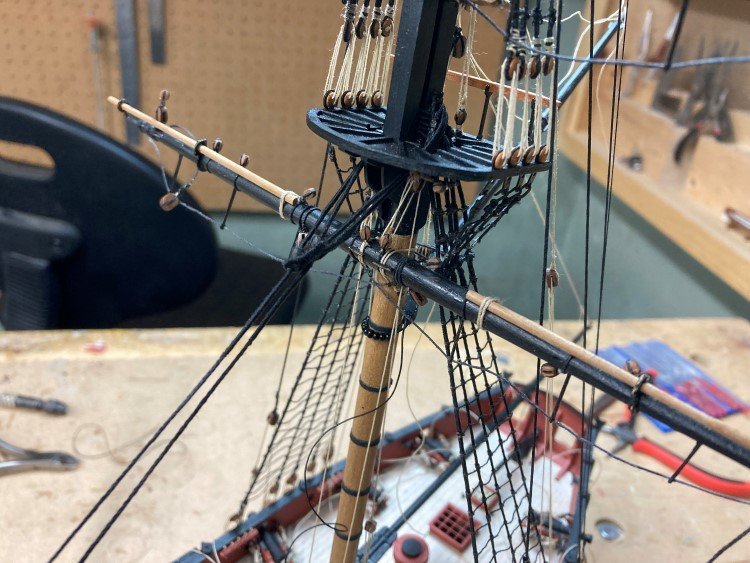
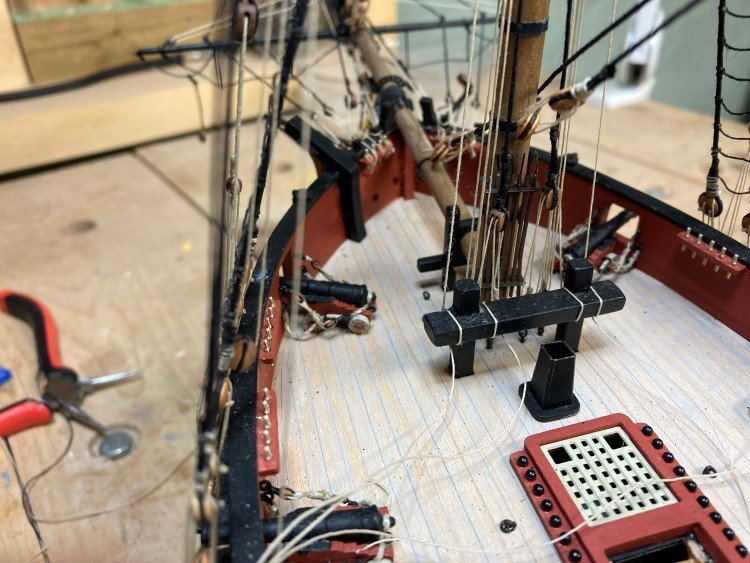
For the trusses, I used these small cast bullseyes from Bluejacket. I'm a big fan of them and I like to keep a supply of them on hand. They come in several different sizes, but I really like the smallest ones - 1/16" inch - because they're easy to use and never look over scale.
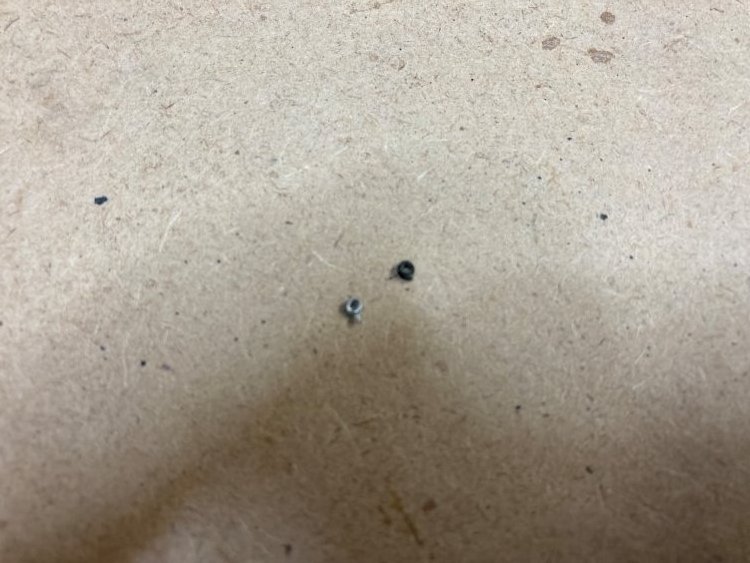
They blacken easily and just need a small amount of cleanup. (Of course when all is said and done, you can't even see them on the trusses, but at least I know they're there.)
Parrels and ties on the topsail yards -
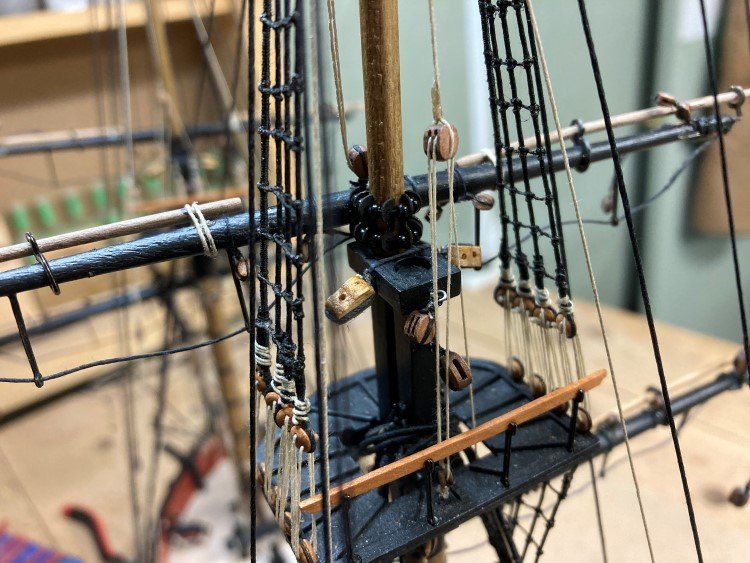
Ties on the topgallant yards -
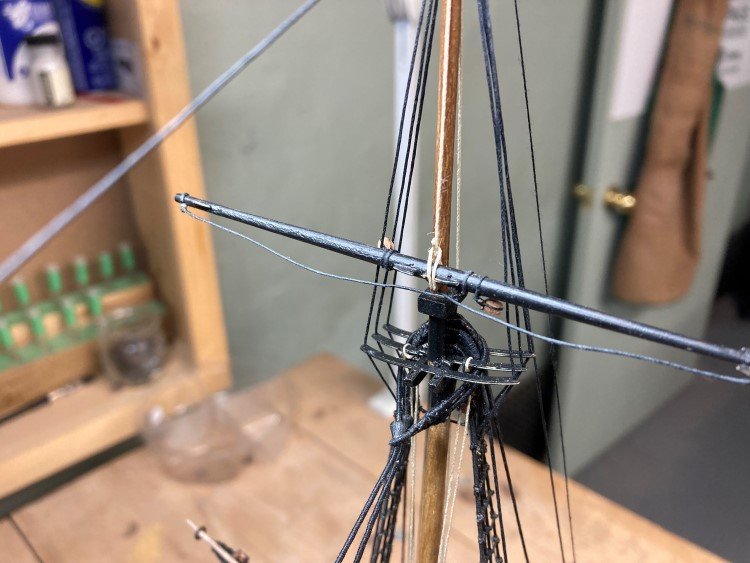
There isn't really too much to explain about my methods. I just added each according to the plans. It was all pretty straightforward and free of problems.
I've started working on the boom and gaff. The completion of this build is actually within sight; then I will turn my attention to Agamemnon in earnest.
Thanks again for likes, comments etc. Very much appreciated.
David
-
Hi guys, thanks for all your comments. Just getting to them now, as I have been away for the week at the Habitat for Humanity Canada national conference. (I'm the local affiliate chairperson.) It felt both good and unsettling at the same time to be meeting again in a large group.
Tom - I have noticed the boat you're referring too. Maybe next time.
Derek - I am definitely using black ratlines next time too.
Thanks again,
David
- chris watton and Dave_E
-
 2
2
-
Dave, you can do this! You definitely need to use tweezers. I always belay the lines on the side of the ship that is away from me, reaching across the deck. I like to reach in with tweezers and wrap the line around the pin once, and only once, and secure it with as small a dab of glue as I can get away with. I always leave the line long and don't cut it off too soon because as carefully as I think I've gauged the tension, it's highly likely that at some point along the way, I'll have to pry that line loose and readjust it slightly as I work on subsequent lines. Only later do I go back and cut the lines off at the pins. I normally use cuticle nippers for most rigging tasks, but here they won't work. You need scissors that are long enough to reach in. And it takes care! It is surprisingly easy to cut the wrong line, or cut the line on the wrong side of the pin, etc. etc.
I think most would agree that the best way to make the coils is separately and off the model. There is one basic way to do this, but there are many variations on it. There are examples on the forum as well as youtube. It's a matter of experimenting until you find the one that seems to work for you. (However, I must warn you, they are all frustrating.) Then add the coils to the belaying pins.
I don't think I care very much for those fat belaying pins either, and like you, would be inclined to replace them with finer brass ones. It appears this would require new pin racks with smaller holes. They aren't too hard to make from scrap material. I agree with Allan, that it looks like it's still possible to do that, if you think it's worth it, or maybe you'd be just as happy working with the existing pins - they'll certainly work.
You might just be suffering from something that affects me on every build - as I'm nearing the end of the building part, I can't wait to get started on the rigging, and then very soon into the rigging, I wish I was back working with the wood again. And that's when I start dreaming about the next model.
Don't give up now. Your model is very good and I'm sure you'll finish the rigging as skilfully as you've done everything else.
David
- Keith Black, Dave_E, SUBaron and 1 other
-
 4
4
-
-
OK, the thing I like the least about any build is the (bleeped) little boats. I never have good luck with them. The Charles W. Morgan had seven of them and it was almost the end of me.
Thank goodness there's only one for the Speedy, and at long last I have it finished. Initially, I messed it up so badly, that I had to order a new one. And by the way, for those of you in Canada, I discovered that Vanguard has a distributor here -The Crafty Sailor, which provides very good service. So I bought my replacement one there.
Here are a few representative pictures:
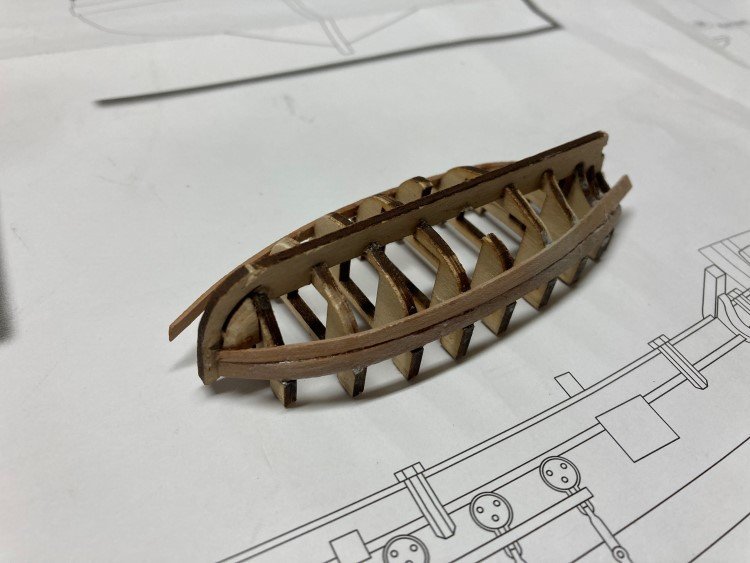
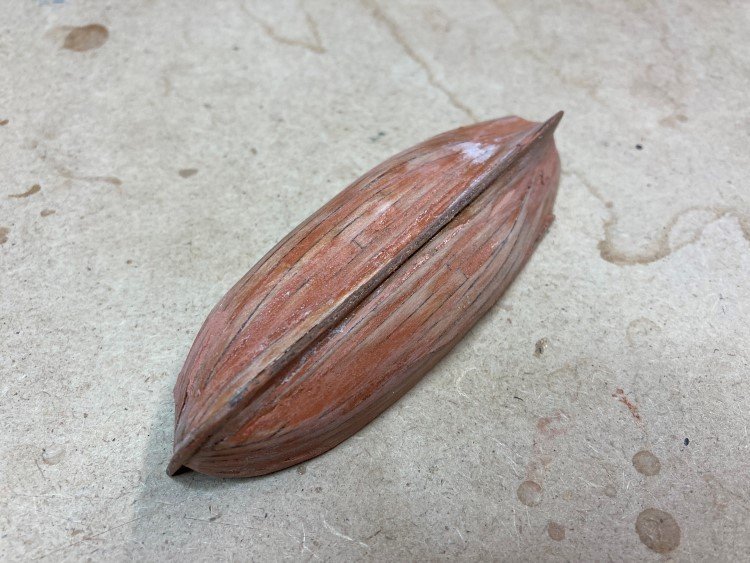
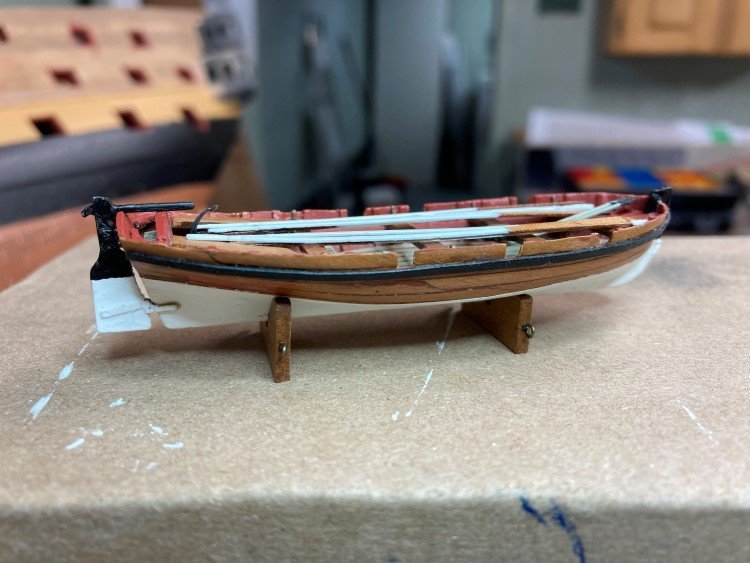
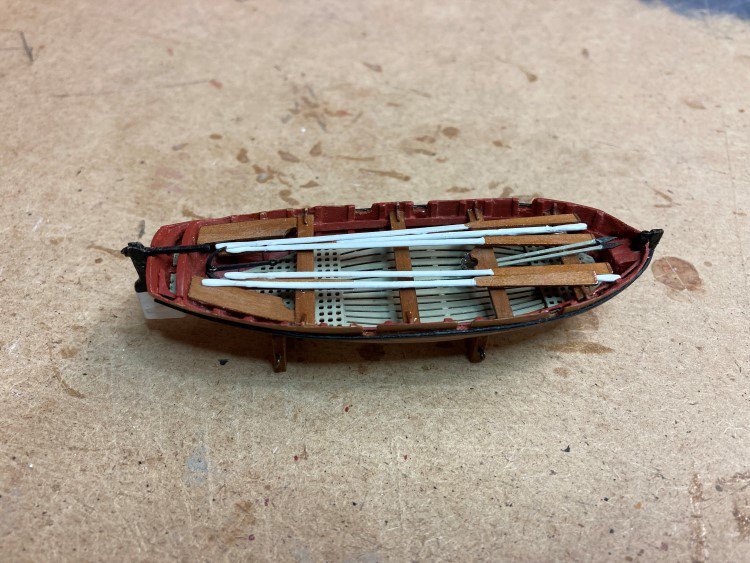
I've had the interior together, taken apart and back together again so many times, I've lost count and I've stripped and repainted the white paint at least three times. In any event, I think the result is now acceptable, and it will have to be, because that's as good as it's going to get.
I enjoy every other aspect of a build, but for some reason these boats always have me strung out. I'm not sure why. I have four of these coming up for Agamemnon, so I think I might get them out of the way sooner rather than later, then I can relax for the rest of the build.
I've also been making progress of the Speedy rigging, which will be in my next update.
Again, thanks for checking in!
David
- Dave_E, Seventynet, whitejamest and 15 others
-
 18
18
-
-
Your LN is looking great Dave. You mentioned getting blocks attached to eyebolts on the deck. Have you glued the eyebolts in yet? If not, it's easy to attach a block and eyebolt together and then glue the eyebolt and block assembly in place. If you have already glued the eyebolt in place, it's harder, but only by a little bit and will probably involve a bit longer piece of thread. Do you know about a "figure of eight" seizing?
Thread the line through the eyebolt, then make a "figure of eight" and add a seizing. Place the block in the loop and slide the seizing up tight against the block. Then you can pull both ends of the line and the block will snug up against the eyebolt. If you use a fairly long piece of line, you can add the seizing well away from the deck, where it's easy to hold the line in your "helping hands" clip.
This is also how I would attach a block to a yard, as you asked in an earlier post.
I hope I'm understanding your question correctly and I'm sorry if this is redundant.
David
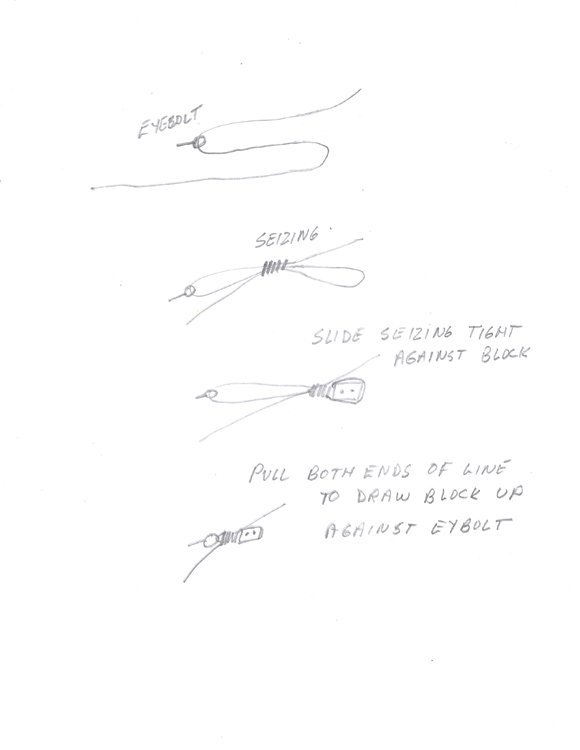
-
Good Morning,
Time for an update. I have pretty much finished the standing rigging. I don't really have too much comment to make as it all went very routinely.
Topmast shrouds in place -
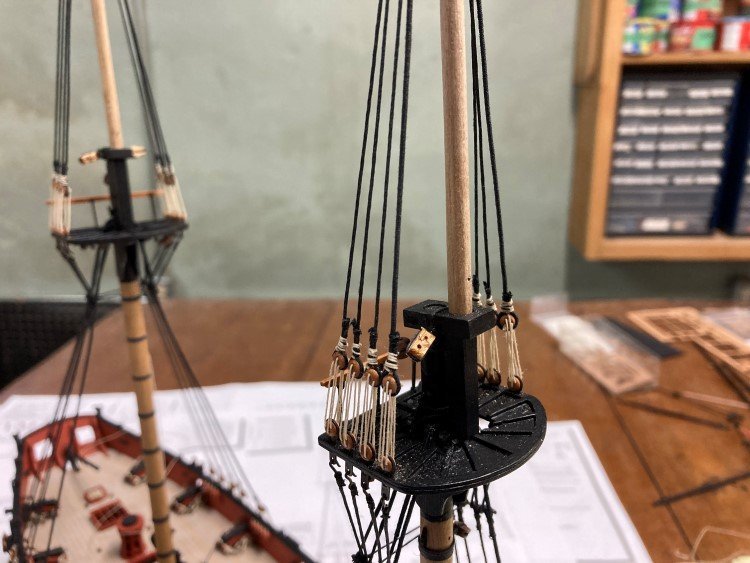
Ratlines - I have always used black thread in the past for the ratlines, but the instructions here called for natural thread to be stained afterwards. Does anyone know why that would be? Is natural thread inherently better for ratlines than black thread? In any case, I decided to give it a go. I used India ink to colour them.
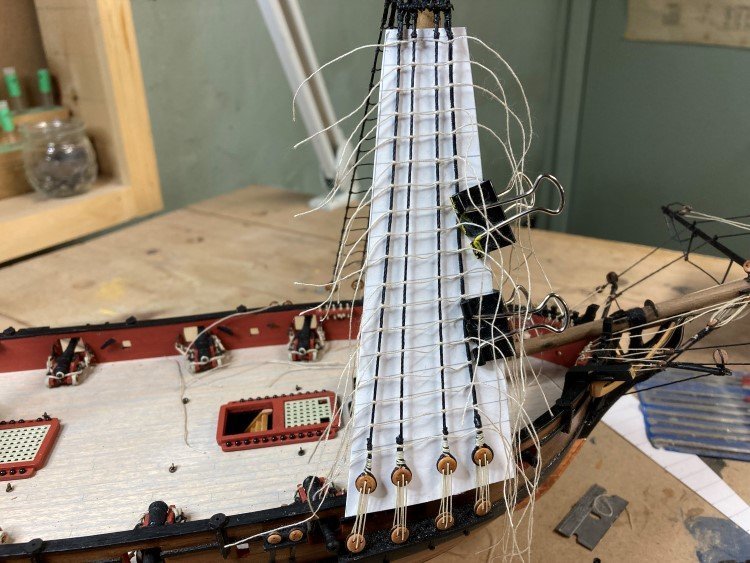
I decided to try to make my own mouses (mice?) for the forestays. I started with a 1/8" dowel and drilled about a 1mm hole into the end of it. Then I started paring the wood away with an xacto knife, sanded it smooth and then cut it off.
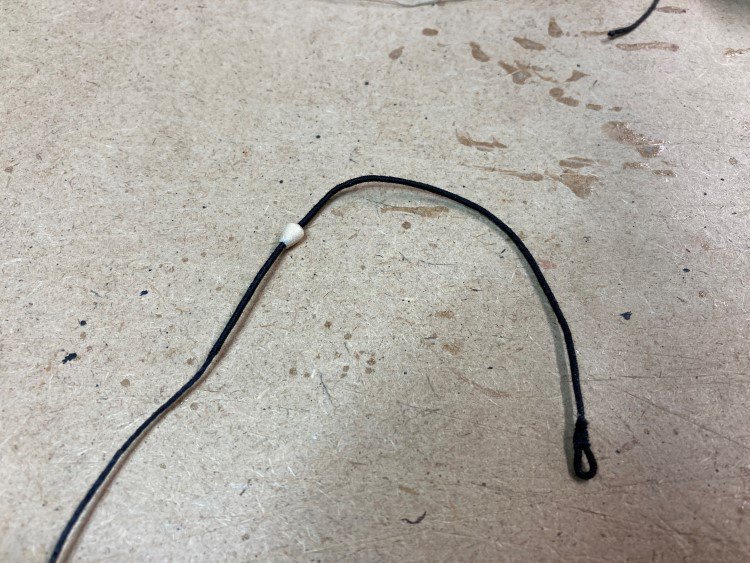
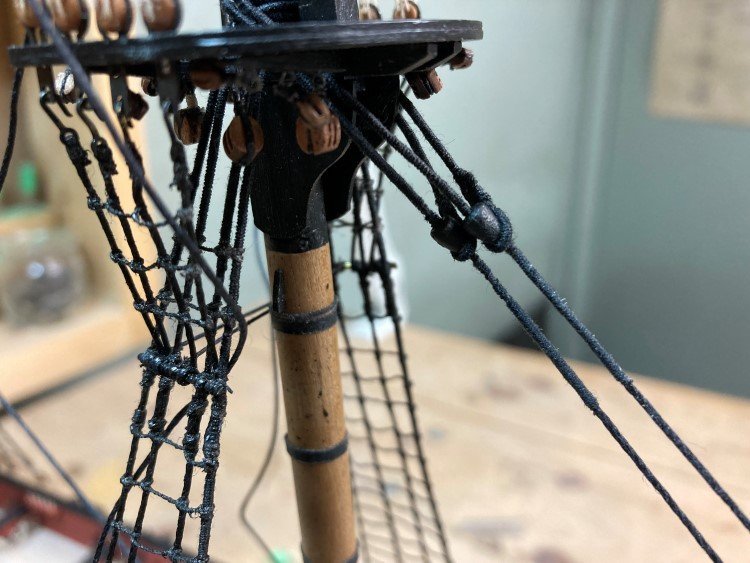
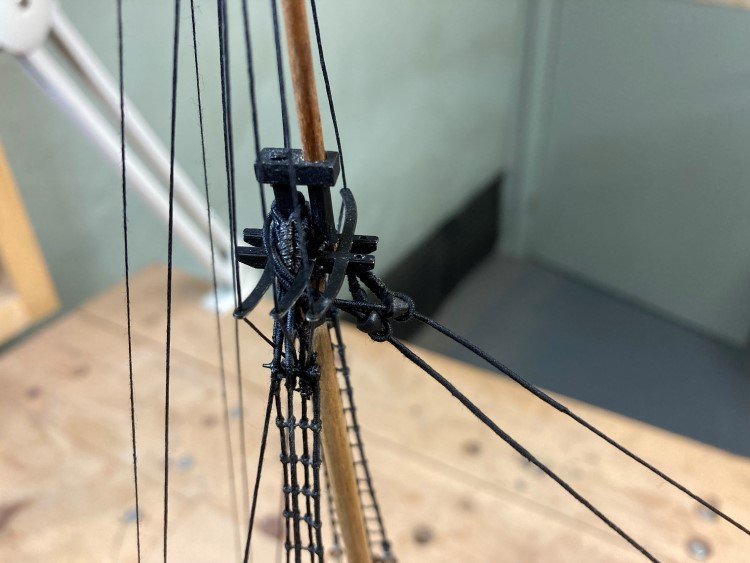
Once I was happy enough with the tension, I glued and trimmed all the lines -
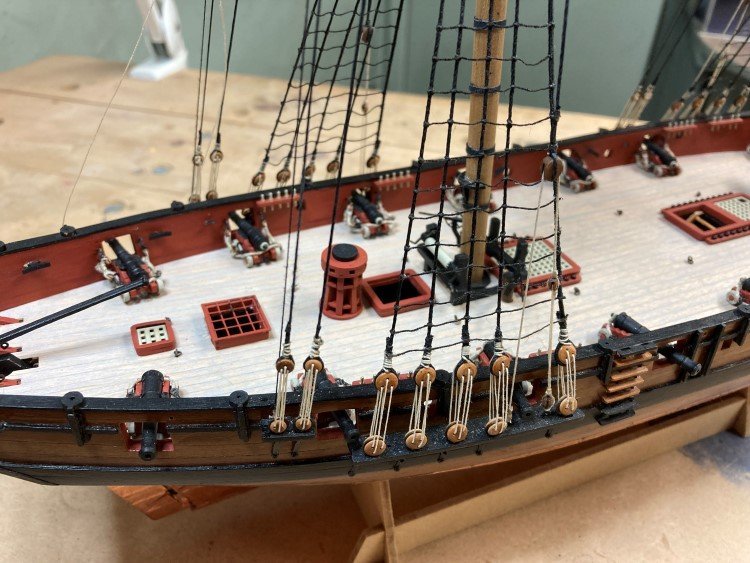
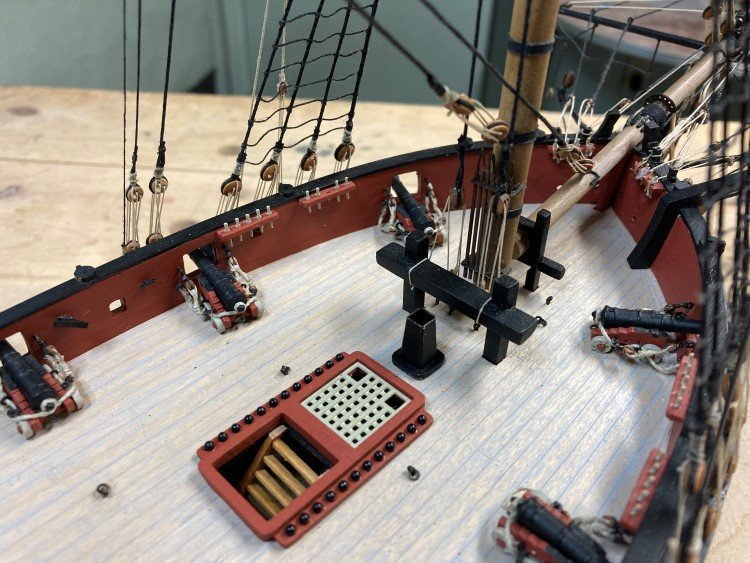
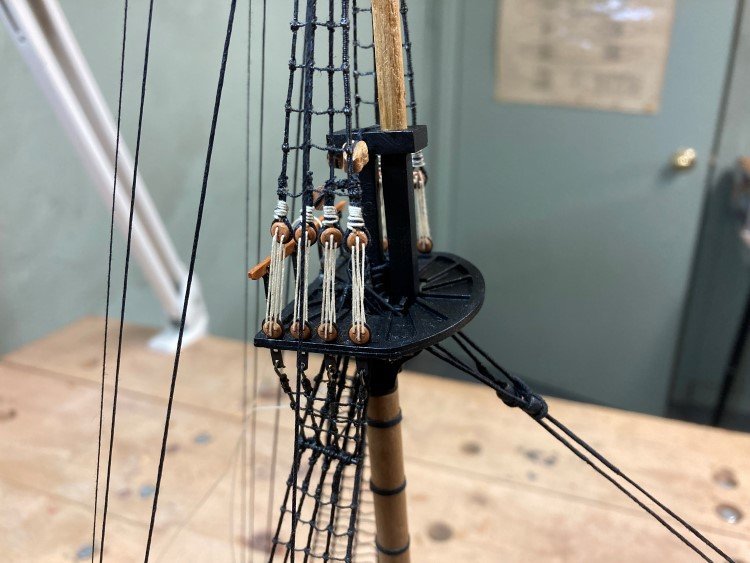
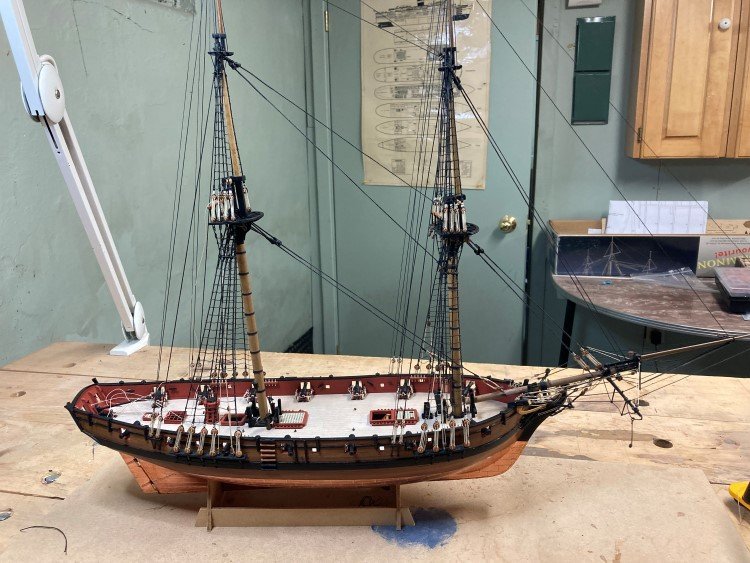
So next up is the lower yards.
David
-
Dave, that mast is looking pretty good. I've never tried using a drill, perhaps I'll give it a go next time.
I have always scraped my spars to shape them. I use a #22 xacto blade and draw it towards myself, turning the dowel as I go. I've also done this with square stock, but I usually use the kit supplied dowels. I've never really had a problem with them. You can remove a lot of material surprisingly fast. There is still a fair bit of sanding to do, but the scraping gets the bulk of the work done. The result is never 100% perfectly round as it would be using a lathe, but it's not hard to get very close to perfect and certainly close enough for my eye.
David
- Ryland Craze, mtaylor and Dave_E
-
 2
2
-
 1
1
-
Hi Fred,
I've built quite a few models over the past few years and have enjoyed all of them, but the Morgan was my favourite. It's a really great kit and there are many photos of details available on line, which is a great resource.
I hope you have as great a time with it as I did!
David
-
Thanks for likes etc. everyone.
Dave - I didn't open the chainplates exactly the way Derek did. I just grabbed each one with two pairs of pliers at the base of the circle and gently pulled in opposite directions to open it a little wider; it doesn't take very much. Once the deadeye was in place, I just gently squeezed it back together just below the deadeye. It seemed to work ok.
Theodosius - There's no serving line in the kit, so I just used common garden variety "sewing thread" that I buy at a local sewing store. I usually always get Gutermann, as that's the main brand they carry, but last time I was in I found some other brand (I don't recall the name), because it was available in a larger spool and I anticipated using much more of it than usual if I was serving. I don't know what weight the thread is, but it's just the usual standard sewing thread.
Hope that's of some help.
Thanks again,
David
- Dave_E, BobG and Theodosius
-
 3
3
-
Thanks Derek,
That Morgan build log by Gerald Spargo is one of the best ones on the forum; it's just too bad it isn't finished. However, I can never seem to remember his sequence for attaching the futtock staves from model to model and have to look it up each time. I also followed his method for building the tryworks on my Morgan. It results in the most realistic brickwork I've seen. His instructions for it are available under resources on the NRG site.
Thanks again,
David
-
Good Morning,
I have just finished the lower shrouds. This is the first time I've served the shrouds and it was quite easy to do. The only tricky part for me was when it came time to seize them. I'm in the habit of attaching the seizing in a convenient spot and then sliding it into position. It's not really possible to slide the seizing on a served line, so it was necessary to seize it in its final location. Not an insurmountable problem, obviously, but it was a minor departure for me. It's a matter of wrapping the line around the mast, then grabbing it with a pair of tweezers, sliding it off and attaching the seizing as close as possible to that point.
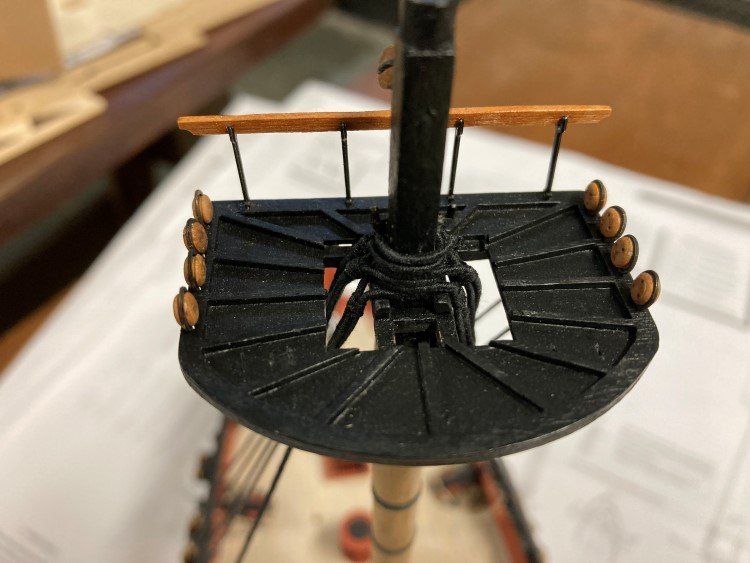
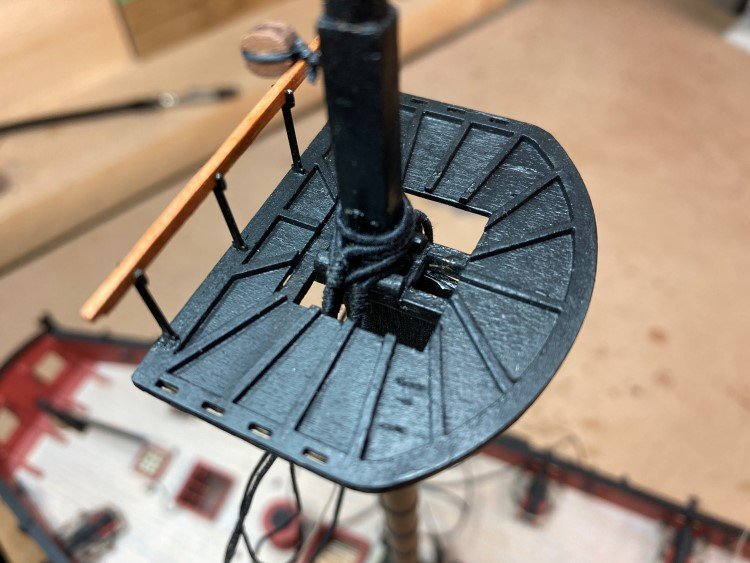
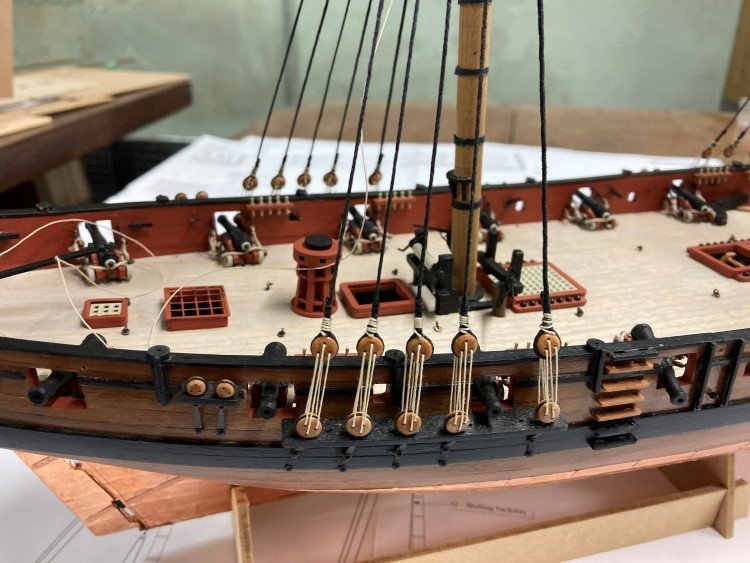
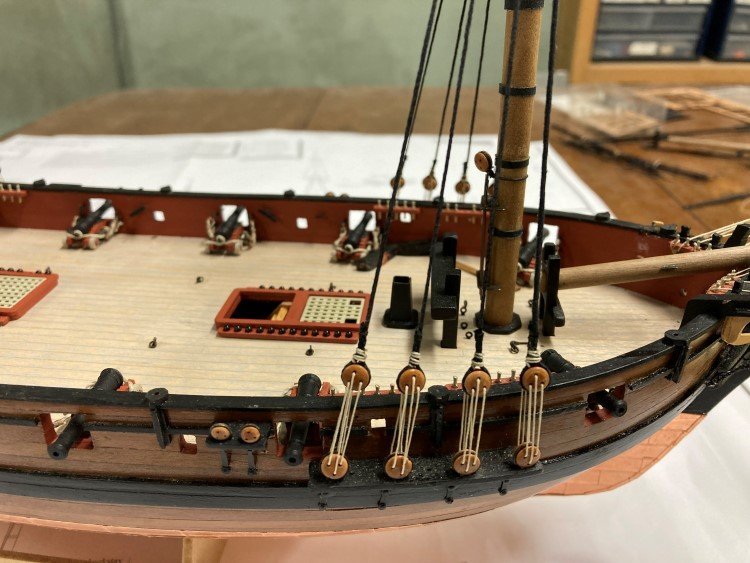
The futtock stave, catharpins and futtock shrouds came next.
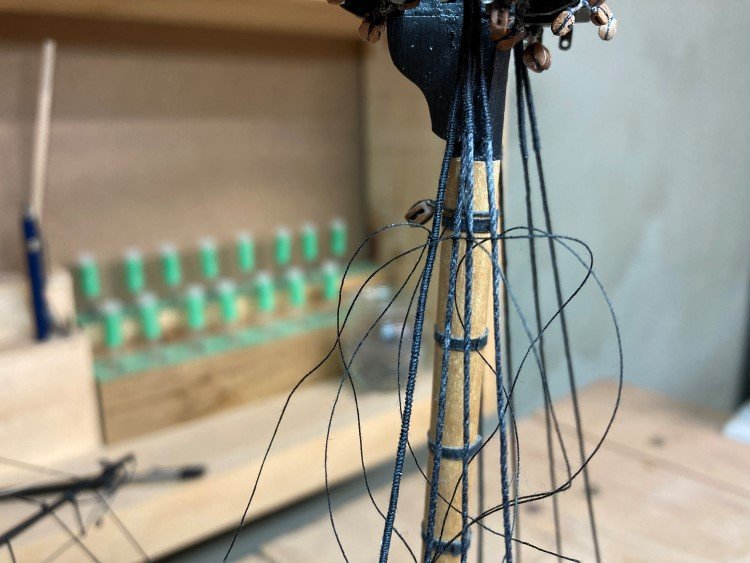
I always found it difficult to attach the futtock stave until I read a technique in a build log for the Morgan by Gerald Spargo. It's the method he used to attach the ratboards (instead of ratlines) on that model and it's really good. I highly recommend checking it out.

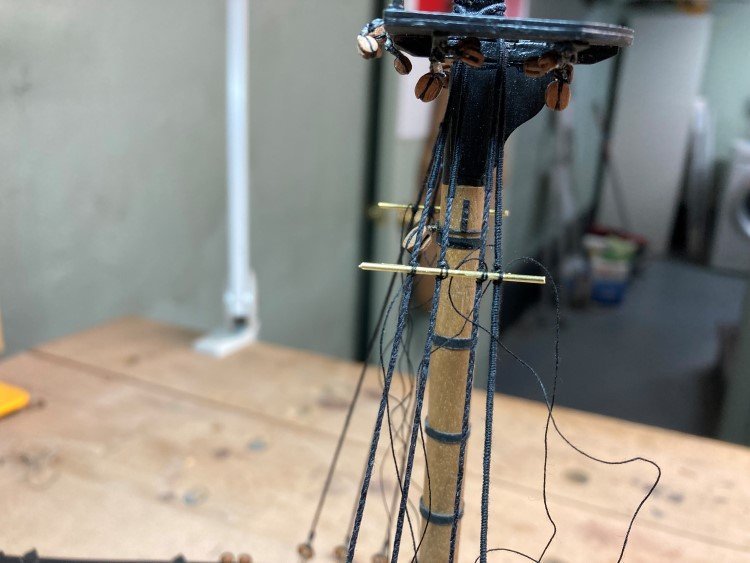
For the futtock shrouds, I can never seem to attach seizing when the line is in the vertical position, so for these I set the model on its side. The stand actually held it in place quite securely and this made the job quite easy. I just backed it up against the heavy base of my helping hands.
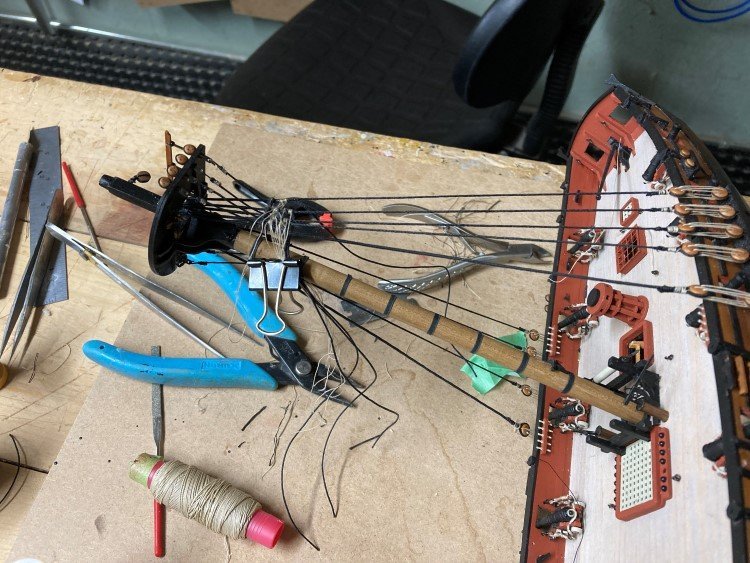
I left the tails on the futtock shrouds quite long, which I thought would make it easier as I could attach the seizings further down on the shroud and then slide them up into position. This worked quite well (except for the served shroud, of course), but it did cause me one problem. It wouldn't be a David build if I didn't have at least one major redo. When trimming the ends of the futtock shrouds, I accidentally cut one of the shrouds instead, which was a real pain to redo. I try to limit it to one per build, so hopefully that's it for this one.
I used white line for the seizings; it really makes it easier to do with the colour contrast and then I later coloured the seizings black with some India ink.
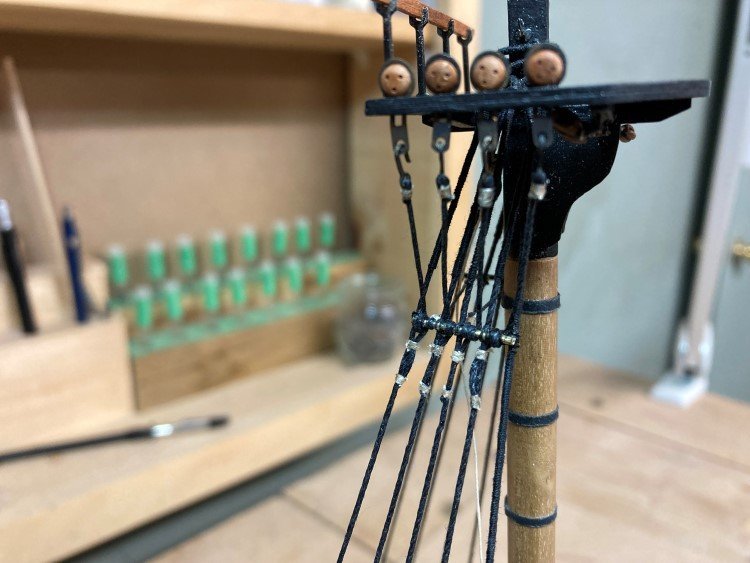
I didn't blacken or paint the brass futtock stave ahead of time. I just dabbed a little "ironworks black" on the exposed bits after and that worked quite well.
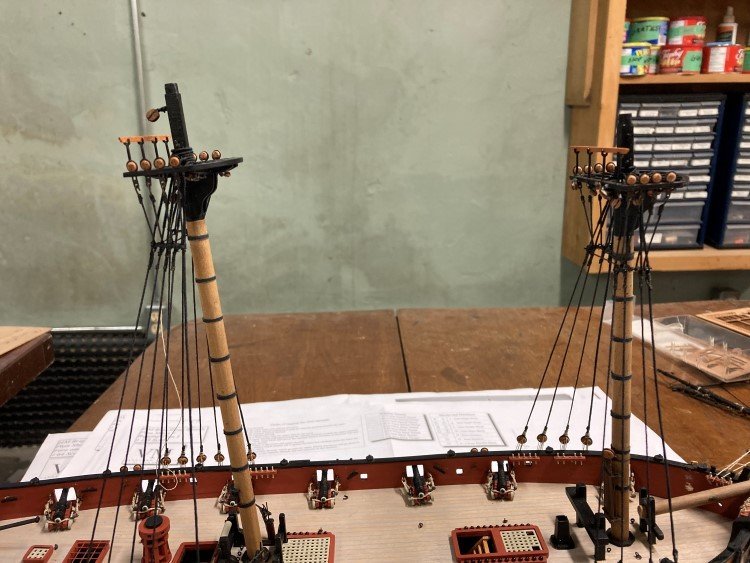
So that's it for now. Thanks again for looking in, likes etc.
David
- Ryland Craze, Dfell, BobG and 11 others
-
 14
14
-
It works perfectly! I'm currently using mine for the first time. A tiny bit of practice is all that's needed.
- mtaylor, Casey and thibaultron
-
 2
2
-
 1
1
-
Benjamin - The plans indicate that the plates should be 7/32" x 3/4" so I used 1/4" copper tape. I can't remember if I cut them at 25/32" which would have given the same small overlap as the 1/4" width gives, or if I just kept it simple and cut them right at 3/4", still overlapped them slightly and didn't worry about it. I kinda think it was the latter. In any case a length somewhere around 3/4" should be ok.
David
-
Good Morning,
Time for a Speedy update. I have launched myself into the rigging. There really isn't too much to explain or talk about here; it's all pretty straightforward.
First, I attached everything that I could to the masts and yards -
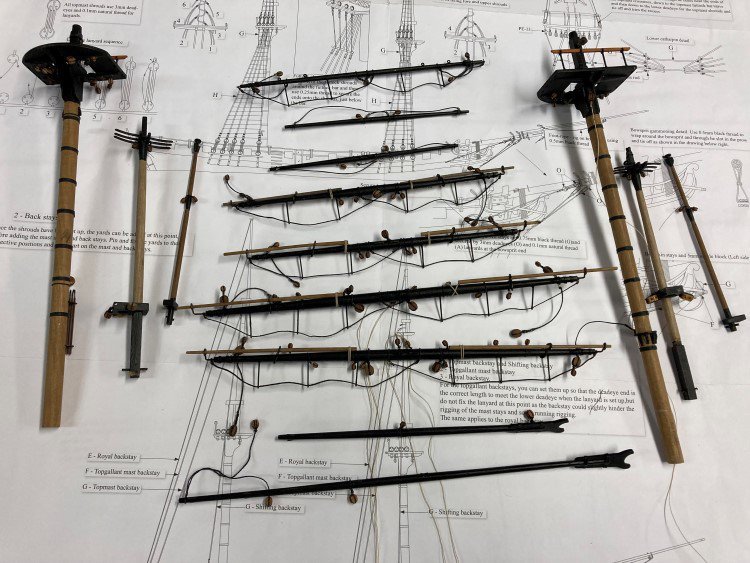
Then, the bowsprit -
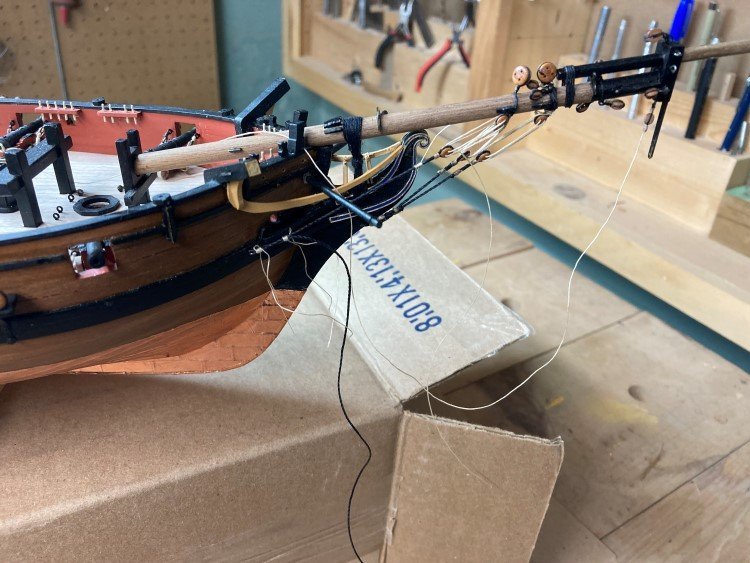
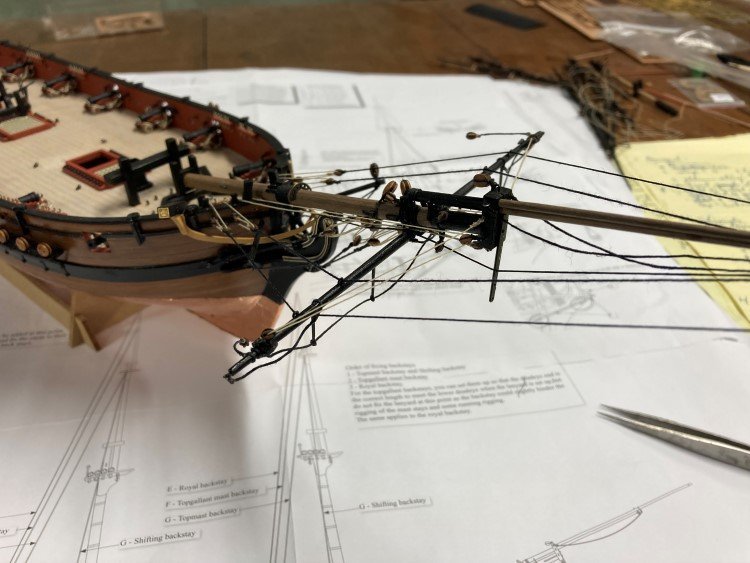
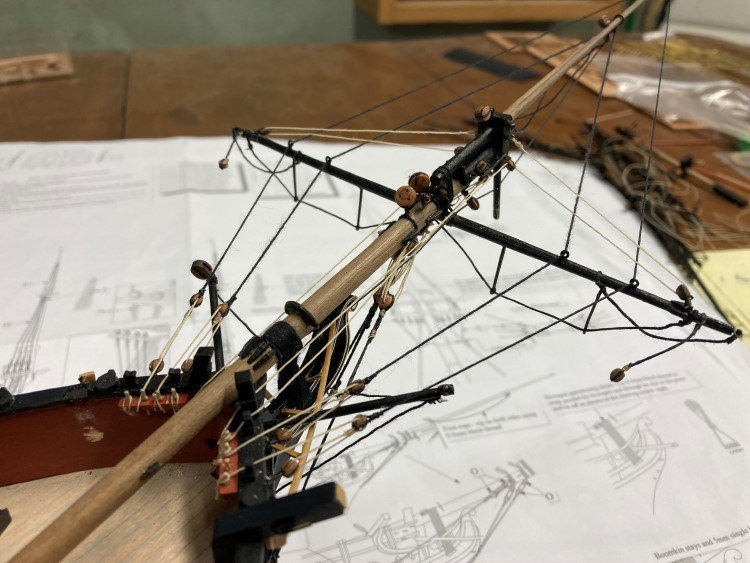
(Just have to re-attach the port cathead and the block on the starboard boomkin.)
The I fired up my serv-o-matic. It's not very difficult to do, but I found I needed a little bit of practice (which always frustrates me, because I figure if I can read, I can do it.) What worked really well for me was to practice using white line with black serving thread. This made it very easy to see just how to lay down each loop without big gaps and without overlapping. After a few trial runs, It became quite easy and goes surprisingly fast.
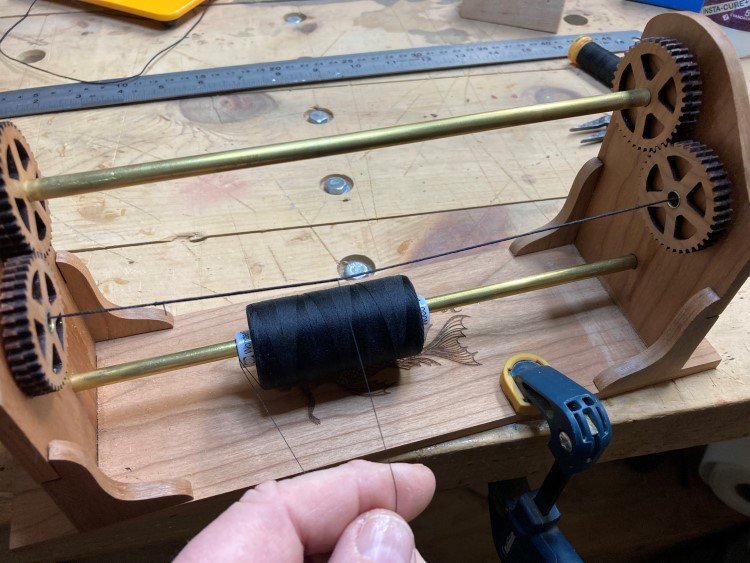
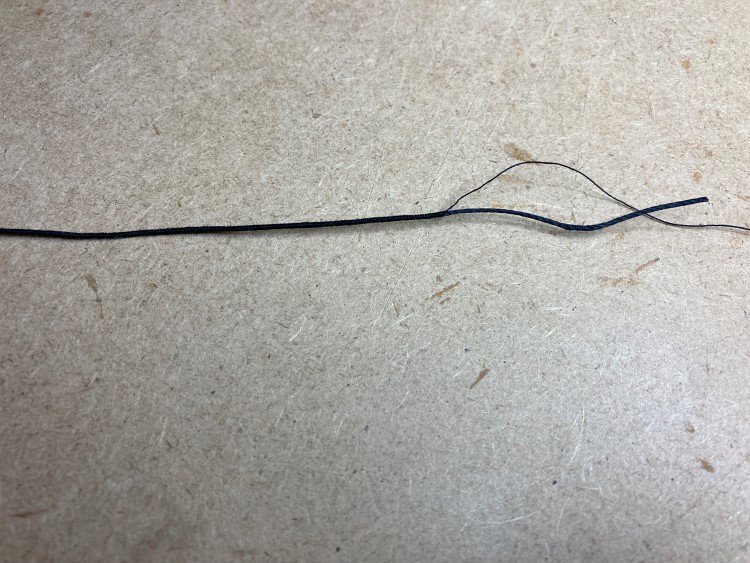
The plans indicate 1 mm line for the lower shrouds. I tried using both 1 mm line and .75 mm line, thinking the serving would bulk up the 1 mm too much. In the end I settled on the 1 mm. I didn't notice an appreciable increase in the diameter, as the serving tends to compress the line a little.
As Derek suggested in his Speedy log, I used a fine needle and "stitched" the serving thread to the line at each end of the run and it made a surprisingly tidy end.
So, I'm happy to be adding this detail to my Speedy.
Thanks for checking in (and happy St. Patrick's day - the Lesters are from County Cavan, but they were all tea teetotallers, so it falls to me to celebrate!)
David
-
Your LN is looking pretty good!
Here are a couple of things about rigging that help me - In my experience it isn't very hard to do, but I always find it can be confusing. Even with several builds under my belt, I still find it's imperative that I write out my own rigging instructions every time. As everyone does, I break it down into individual steps, but I actually write it out for each build - ie. fore shrouds, main shrouds, stays, back stays, lifts etc. etc. I include lots of details, what size block, what size and colour of line etc. etc.I write two separate sets of instructions - one for everything that can be added to the mast and yards before they are installed and a second set for everything that can only be added after the masts and yards are in place. It helps to add as much as is possible before the masts and yards are installed on the model. Some elements are so self-evident that it might seem crazy to be writing it out, but I find it really helps; I just work through my list and it helps keep me sane.
The running rigging can be finicky, but it's not particularly difficult and the shrouds usually don't cause any trouble, but I always find the stays to be the hardest. It seems that as you pull one taut, another one goes slack, or you pull the top end of the mast too far out of whack. Once the bowsprit is rigged and the shrouds are in place, it's time to do the says and after much trial and error, I've found what works for me is to attach the uppermost stays on all masts first. Then they can be adjusted so that they have the right amount of tension and the tops of the masts are in line and not pulled forward or aft. It may seem more intuitive to start with the lower stays and work up, but I find working from the top down works better for me. After the uppermost stays are in place, then I fill in the others and make them just taut enough, without too much tension. Only after all the stays are in place and adjusted, do I add a drop of glue to all the seizings.
Anyway, there are a couple of thoughts for your consideration.
David
- CiscoH, DanB, Keith Black and 1 other
-
 4
4
-
Hi Shane, I can't comment on the Stefano. I know others have had good luck with it, but after my expensive nightmare with the Ontario, I would never choose it for myself. Also, it does look like a pretty big project.
Vanguard would be an excellent choice - any of Alert, Flirt and Speedy. My experience with Speedy, which I'm working on right now, has been excellent. It offers enough challenge, but you don't have to "fight the kit" to get a good result, meaning it's well engineered. And both the plans and instructions are excellent.
I'm also a fan of Model Shipways kits. They have great plans. The instructions are a little weak, but the plans are very comprehensive and the models go together well. They offer many good options.
Anyway, have fun making your choice.
David
- thibaultron and ShaneofGY
-
 2
2
-
Hi Dave,
I would definitely buy the Model Shipways version. I built the Mamoli several years ago and it was fine. I didn't really have any issues with it, but I didn't like the metal "frames" for the gun ports and if I had it to do over again, I would have reduced the size of all the blocks. They look much too large on the finished model when used according to the plans.
I have built many MS kits and I think they're really great and I think their plans are excellent. While I haven't build their Rattlesnake, I have had a peek at its plans. One order I received from MS was packed not with newsprint, but oddly, with crumpled up Rattlesnake plans. I took a good look at them and they appeared to be in line with the usual standard.
Here's my Mamoli one -
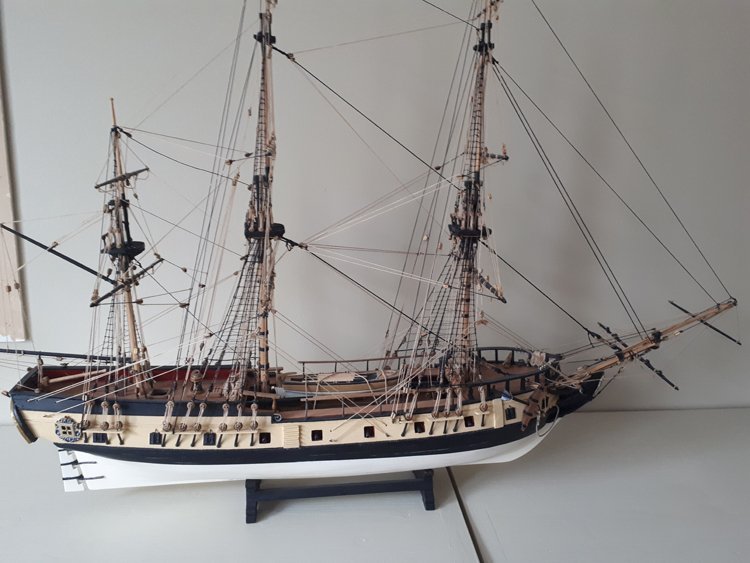
I have always had a special feeling towards the Rattlesnake, because it's really the reason for my interest in model ships. When I was a kid in the late 50's and early 60's my friend's dad built models ships and I was mesmerized by them and I wanted to build them too. He had many of them, but the only one I really remembered well was the Rattlesnake, because of its name. My friend still has his dad's old Rattlesnake model. Here's a picture of it -
.jpg.cb7e2fd54a664b1682c4cde92acdd39b.jpg)
I don't know if this is a kit or from scratch. I can tell it's not either the MS kit nor the Mamoli kit, but it's definitely the Rattlesnake. It's about 60 years old now.
The MS and Mamoli versions look very much alike when finished, and I think you'll have a good experience with either one, but my vote would go for the MS version.
David
-
Hi Dave,
I have quite a few of the admiralty paints and I think they're great. I was also a bit surprised by the yellow ochre at first, but I think when you see it on the hull and contrasting only with the black it will look quite yellow and more like you expected. As to the black, I'm pretty sure "dull black" doesn't refer to the finish, as in matte or flat, but rather to the colour, meaning it is just slightly off a true deep black.
One frustration I've had is that so many model paints are only available in two finishes - either flat or glossy and for many purposes, especially the hull, neither seems right. These admiralty paints have a very nice soft satin finish that I like quite a bit.
David
-
Time for a coppering update. I've spent the past two weeks coppering the starboard side, and here is my take on the experience.
I had so much trouble getting a decent job using copper plates on my Speedy, that I abandoned them and resorted to using copper tape, which I had used successfully a few times before. So I wasn't sure if wanted to use the copper plates again this time, or just go immediately to copper tape. In the end I opted to try the copper plates first, with the idea of falling back on the tape if I ran into serious trouble.
As it turns out, I managed to get an acceptable job using the copper plates. I think part of the reason that I had an easier time here than with Speedy is the fact that the hull is so much larger but the plates are the same size. Overall, though, I think I now have a decided preference for using the tape. It's much more forgiving and to my eye gives a very nice result. That being said, I'm pretty happy with this result too.
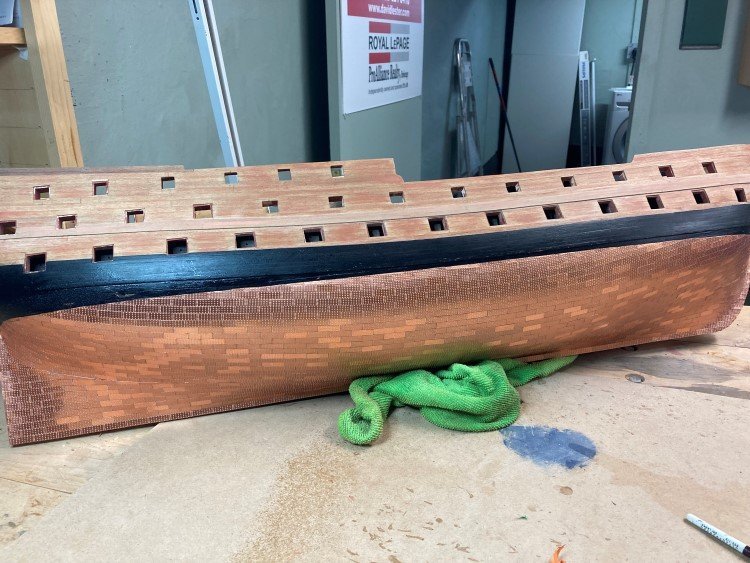
Since the plates can only be applied perfectly if they're in a dead flat, straight line, I wasn't sure how to accommodate the curve of the hull. It seemed I would have to leave gaps in certain places or overlap them. These Caldercraft plates don't lend themselves to overlapping very well, because there is a row of pretty big bumps right at the edges. I thought an overlap would be too pronounced, so I settled on small gaps, but how to minimize them? Just about everything I read suggested to just start laying them in rows from the bottom to the top, with no mention of belts or gores etc. However, on the other hand almost every build log I could see showed signs of partial in-fill rows being necessary.
So, with trepidation, I decided to just start in, play it by ear and see what happened. When I got to the 8th row, I started to find a problem at the stern. In order to keep going, I would have to leave very big gaps to continue, as the hull curved. So I decided to let the 9th row take its natural path and do some in-filling. I did the same thing at the bow, and had to do it one more time further up at the stern. This seemed to be a good approach.
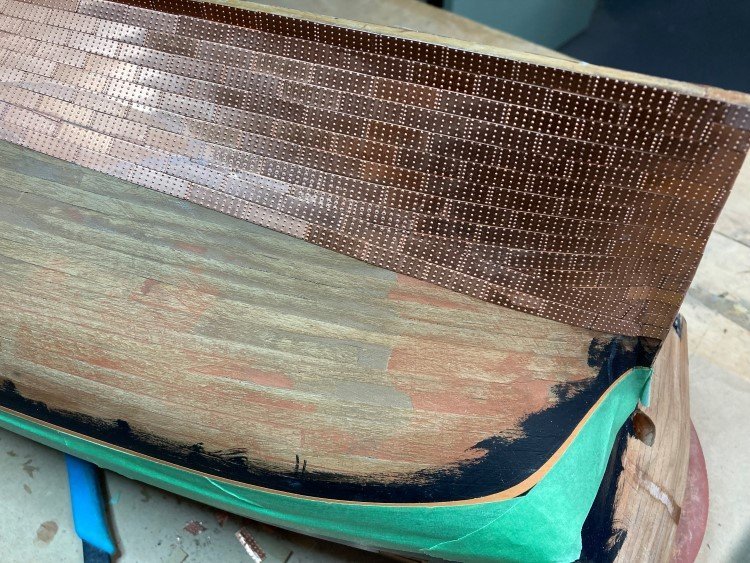
Because I didn't overlap the plates, I found it best to start laying them in the centre and working in two directions. This helped minimize any accumulating error in aligning each plate over the one below it. I found if I worked in one direction only, despite taking care there would be a noticeable shift in the plates and by the time I got to the other end, they would be poorly centred over the one below.
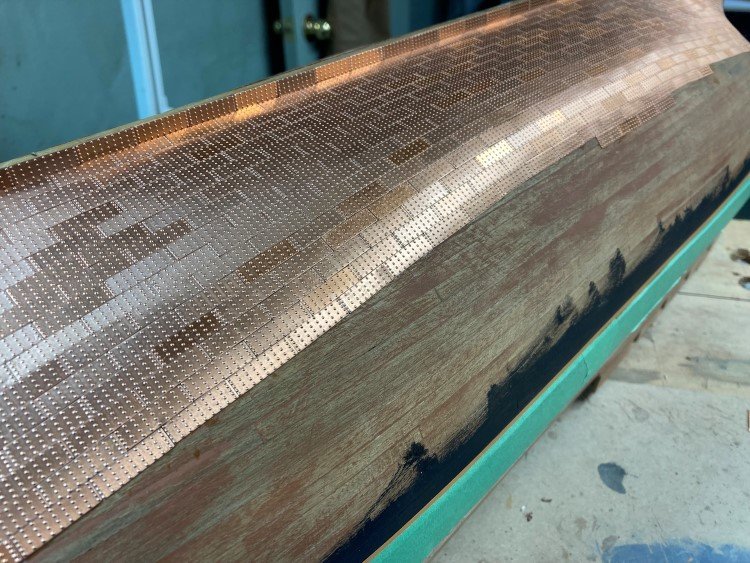
I'm sorry that I can't recall what build log I found it in (I think it was a Victory build log, but I'm not sure and apologies to that builder), but it contained two really great tips. The first was how to cut the plates. They tend to curl if cut with scissors, but if you use a Stanley utility knife blade and a hammer, you can get a beautiful cut.
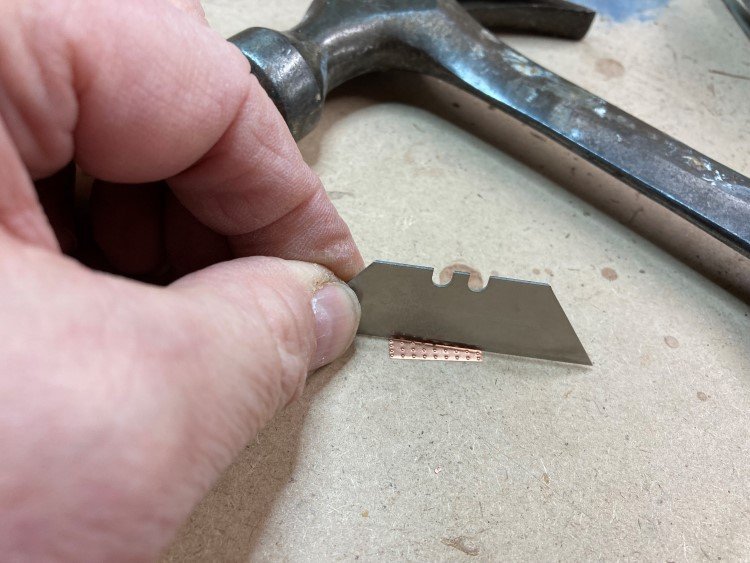
I did find however, that the two pieces would tend to fly off in all directions, so I found that if I taped them to the cutting board with Scotch tape, it held them in place, and I could still see exactly where to place the blade. A really nice thing about this method is if you cut the piece a little bit too big, you can still trim a really small sliver off with no trouble at all.
The second great tip I found from that build log is the idea of placing a strip of copper tape along the the waterline and gluing the last row of plates over it. The cutting at the waterline is especially tricky and this really helps hide any minor imperfections.
One other thing that helped me get a smooth waterline turned out to be the particular masking tape I used. I know Tamiya tape is great, but for this job I used narrow Probrand Fine Line tape. It sticks incredibly well and takes the curve of the hull beautifully. It's a little thicker than Tamiya and I was able to butt my row of copper tape up against it easily and accurately. (It's the narrow orange tape between the copper and the green masking tape.)
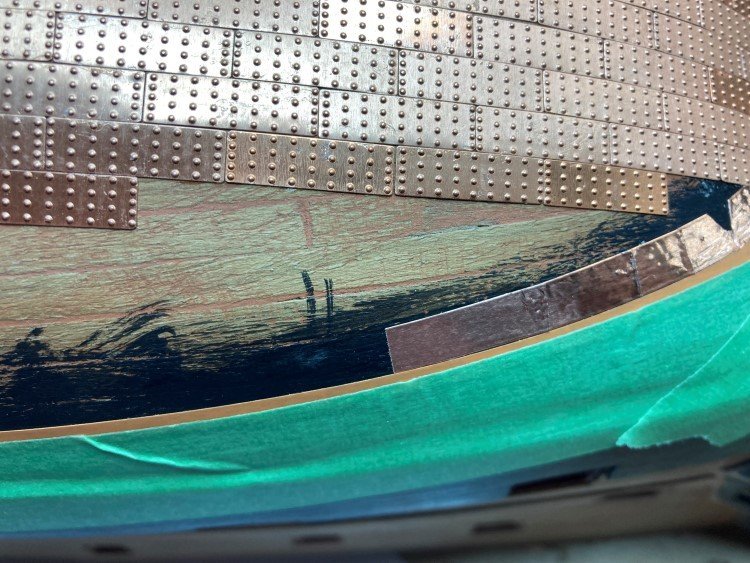
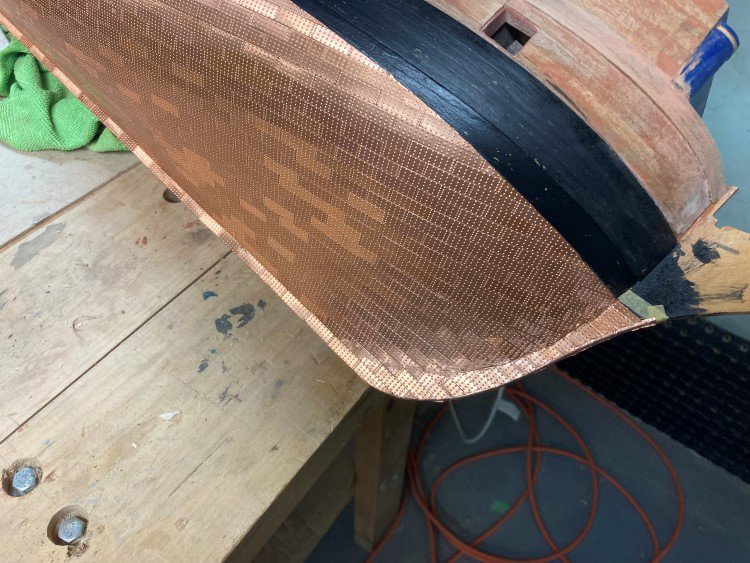
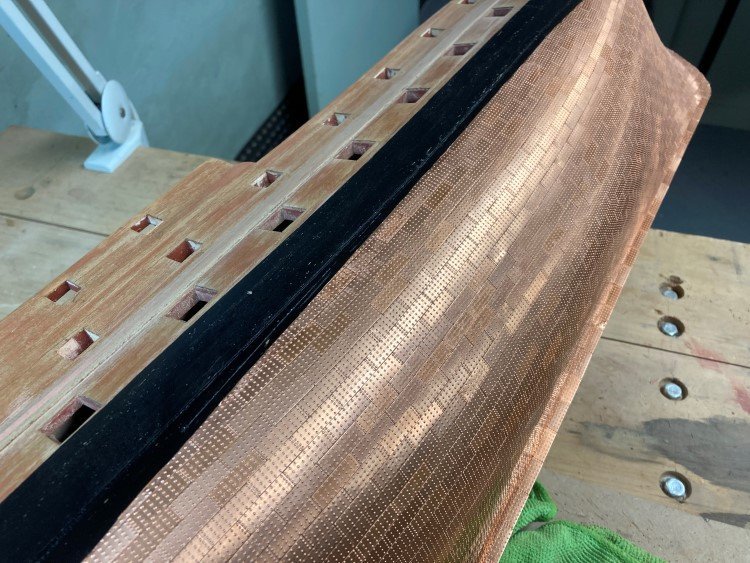
So that's my experience with coppering using plates! I think I'll put Agamemnon aside for a little bit and return my attention to Speedy. I never thought I would like working on two models at the same time, but I'm finding I really like being able to change gears completely.
Thanks for looking in, likes, etc.
David
- mort stoll, Ian_Grant, Henke and 9 others
-
 12
12
-
Hello All,
I'm taking a little break from Speedy and doing some more work on Agamemnon.
I've now finished the second planking on both sides and I'm currently installing the wales.
The second planking is filled and sanded and is pretty good shape for painting.
There is a main wales and an upper wales and getting them located properly is fairly important and it takes a bit of care.
The two wales run parallel the whole length of the ship.
I started by marking the water line with masking tape (I realize this will need re-marking when I do the painting and coppering, but I want it in place now to ensure that the main wales ends about where it's supposed to.
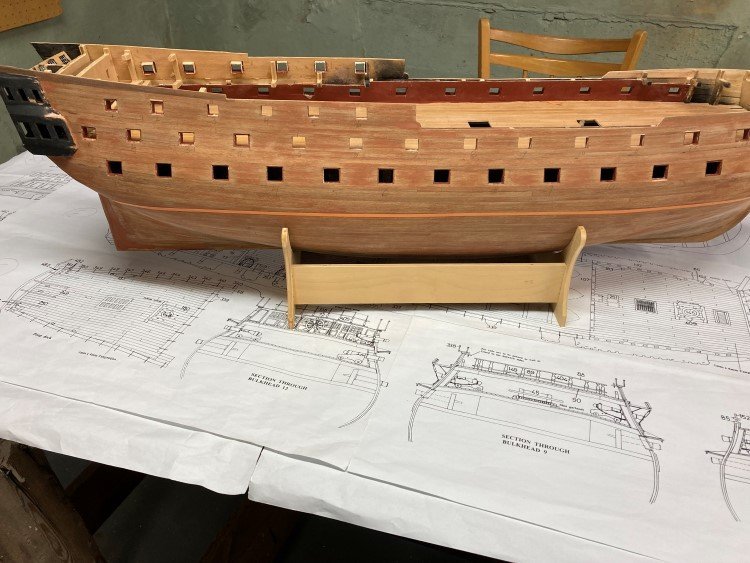
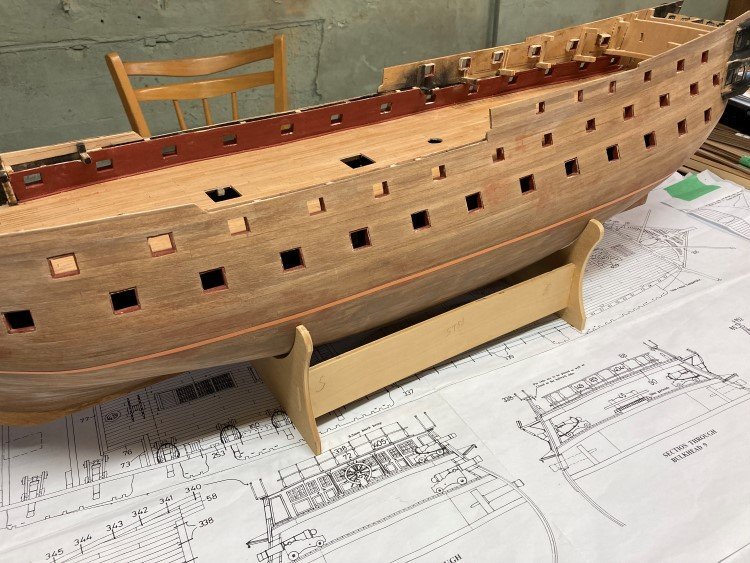
I then marked the position of the top of the upper wales with masking tape -
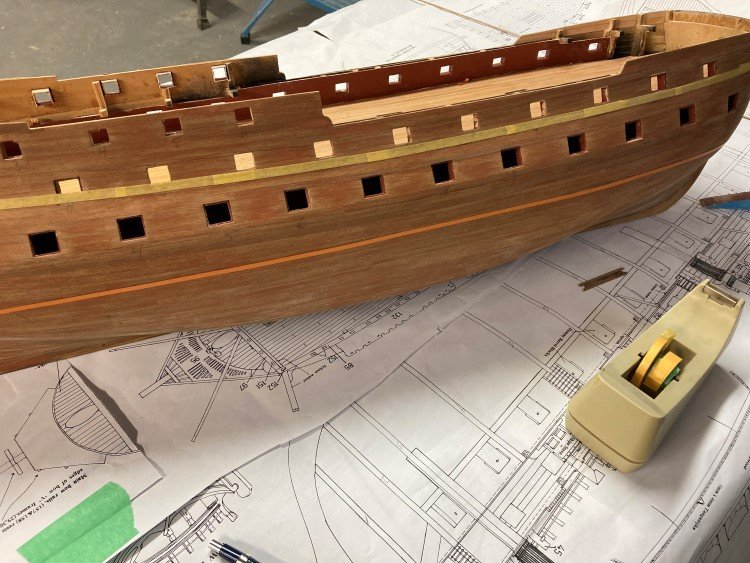
I installed the upper wales first. I then set a compass to the distance between the wales and ran it along the lower board of the upper wales to mark the top location of the main wales.
Before adding the main wales, I glued up a short "panel" of the same width and noted its location with respect to the waterline. It's just fraction higher than shown on the plans, but I think it's perfectly acceptable. I have a bit of filling and more sanding to do.
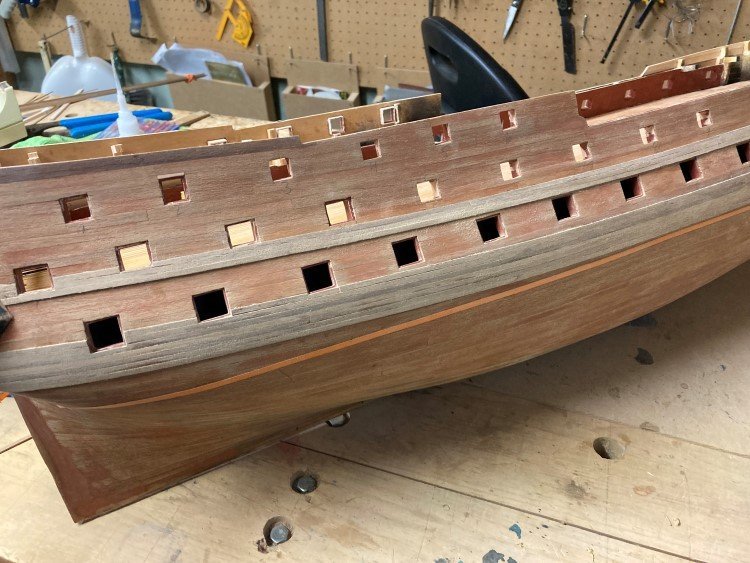
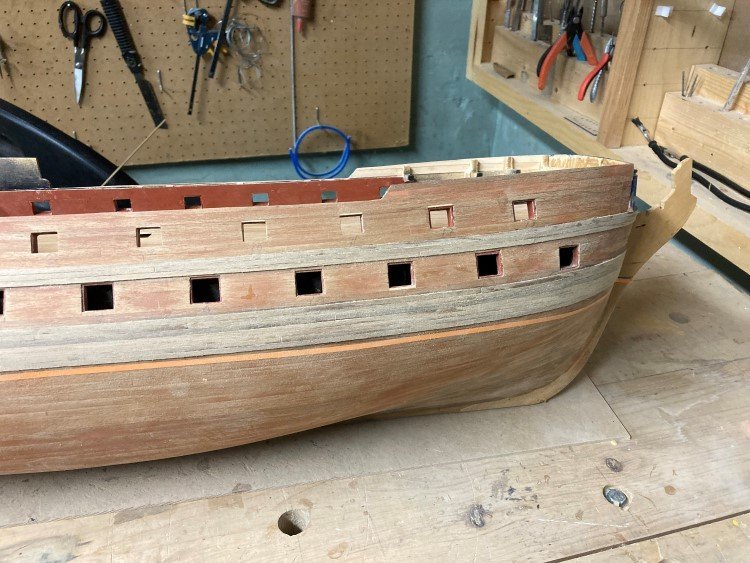
It's always a nightmare painting the upper edge of the wales when it's a contrasting colour from the hull and I never know the best way to tackle it. In the past I have tried painting that area of the hull first (in this case that would be the yellow) and then painting the edge of the top board black before applying it. It looks great initially, but when I paint this soon, despite my best efforts, I always seem to mess up the finish somehow (drops of glue, holes drilled in the wrong spot etc.) and much touch up is needed. Sometimes the touch up is so much that I am essentially repainting anyway and the whole advantage of having painted first is lost. So this time, I'm adding the wales before painting and we'll see how that goes.
It looks like I'm getting quite close to coppering time and I am of two minds on this. On the one hand I would like to use the kit supplied plates. On the other hand, I had so much trouble with them on Speedy, that I think I might be better off just using copper tape, with which I have had good success in the past. I'm still thinking about this one.
David
David
- yvesvidal, Theodosius, Ian_Grant and 10 others
-
 13
13
-

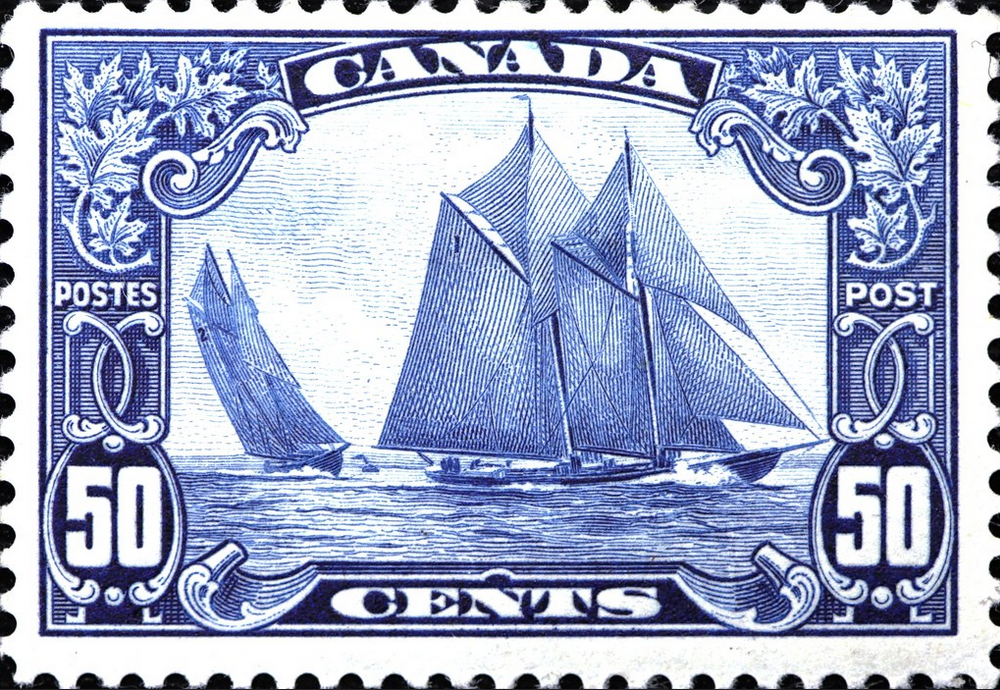

Seizings - what am I doing wrong?
in Masting, rigging and sails
Posted
Thanks for all the feedback guys. I don't feel so bad now. I now feel empowered to continue to use CA without beating myself up over it as if its use was some sort of character flaw. I'll strive to apply the glue as carefully and sparingly as I can.
James - I've already started to touch up the seizings with flat black, not because of the glue, but because I've started using light coloured thread for the seizings on black line. The contrast makes it easier to get a nice even wrap.
Allan - thank for the video link; that's a great explanation.
Thanks again
David